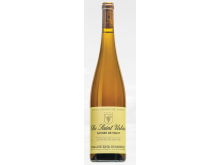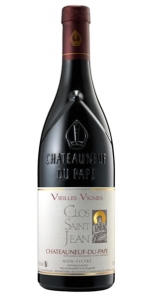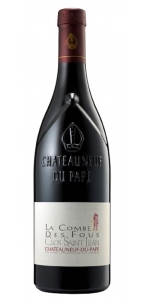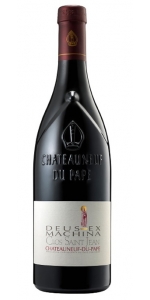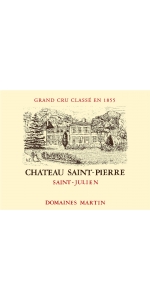Zind Humbrecht Clos Saint Urbain Gewurztraminer 2019
| Country: | France |
| Region: | Alsace |
| Winery: | Zind-Humbrecht |
| Grape Type: | Gewurztraminer |
| Organic: | Yes |
| Vintage: | 2019 |
| Bottle Size: | 750 ml |
Clos Saint-Jean Chateauneuf Du Pape Vieilles Vignes is made from a Grenache, Syrah, Mourvedre, Cinsault, Vaccarèse and Muscardin, the Châteauneuf-du-Pape Vieilles Vignes is made from old vines located in and around Le Crau. The Grenache is aged in concrete for 12 months while the remainder is aged in demi-muid.
Review:
This has good concentration and energy to the dense core of dark fruit and bitter cherry, with great poise and elegance despite its ripeness (an impressive feat for the vintage). Guided by finely crushed mineral accents and tannins, this reveals pretty high-toned floral notes and leafy tobacco. Grenache, Syrah, Mourvedre, Cinsault, Vaccarese and Muscardin. Drink now through 2032. 900 cases made.
-Wine Spectator 95 Points
Clos Saint-Jean is a 41-hectare estate in Châteauneuf-du-Pape run by brothers Vincent and Pascal Maurel. Considered by many critics and wine-writers as the preeminent estate espousing the modern style of winemaking in Châteauneuf, this cellar is one of the oldest in the region, having been founded in 1900 by the greatgreat-grandfather of Vincent and Pascal, Edmund Tacussel. A short time after its founding and well before the AOP of Chateauneuf-du-Pape was created in 1923, Edmund began bottling estate wines in 1910.
The farming at Clos Saint-Jean is fully sustainable due to the warm and dry climate, which prevents the need for chemical inputs. Instead, Vincent and Pascal employ organic methods for pest control, mainly pheromones, to prevent pests from taking up residence in their vines, a process called amusingly enough in French, confusion sexuelle. The vines tended manually, and harvest is conducted in several passes entirely by hand.
Combe des Fous literally means, the hill of the fool. The hill, in this case, is located in the far southern reach of Le Crau which was left barren for many centuries because the layer of galets was so exceedingly deep that everyone assumed vines could never survive there. The fool in this situation is Edmund Tacussel, the great-great-grandfather of Vincent and Pascal Maruel who planted a Grenache vineyard on this site in 1905. That old-vine Grenache form the heart of this cuvée with a small amount of Syrah, Cinsault and Vaccarèse. La Combe des Fous is only made in the best vintages.
Review:
This has good concentration and energy to the dense core of dark fruit and bitter cherry, with great poise and elegance despite its ripeness (an impressive feat for the vintage). Guided by finely crushed mineral accents and tannins, this reveals pretty high-toned floral notes and leafy tobacco. Grenache, Syrah, Mourvedre, Cinsault, Vaccarese and Muscardin. Drink now through 2032. 900 cases made.
-Wine Spectator 95 Points
Clos Saint-Jean is a 41-hectare estate in Châteauneuf-du-Pape run by brothers Vincent and Pascal Maurel. Considered by many critics and wine-writers as the preeminent estate espousing the modern style of winemaking in Châteauneuf, this cellar is one of the oldest in the region, having been founded in 1900 by the greatgreat-grandfather of Vincent and Pascal, Edmund Tacussel. A short time after its founding and well before the AOP of Chateauneuf-du-Pape was created in 1923, Edmund began bottling estate wines in 1910.
The farming at Clos Saint-Jean is fully sustainable due to the warm and dry climate, which prevents the need for chemical inputs. Instead, Vincent and Pascal employ organic methods for pest control, mainly pheromones, to prevent pests from taking up residence in their vines, a process called amusingly enough in French, confusion sexuelle. The vines tended manually, and harvest is conducted in several passes entirely by hand.
Deus ex Machina is a literary and dramatic term for a miraculous intervention that interrupts a logical course of events in a plot or play. A suitable name for a cuvée that had it’s start in the torrid vintage of 2003 when Philippe Cambie and Vincent Maurel made the decision to harvest at the end of September, weeks after their neighbors. Deus ex Machina is a blend of old vine Grenache from La Crau, aged in tank with equally ancient Mourvedre from the sandy soils of BoisDauphin aged in demi-muid. Deus ex Machina is only made in the best vintages.
Review:
Lastly, the 2022 Châteauneuf Du Pape Deus-Ex Machina shows a similar profile to the Combes des Fous, yet it brings another level of tannins and concentration. Kirsch liqueur, white flowers, sandalwood, cured meats, and graphite notes all shine here, and it's full-bodied, has a deep, layered, powerful, yet weightless profile, lots of ripe tannins, and a blockbuster of a finish. This ripe, sexy, seamless, incredibly impressive beauty will compete with anything in the vintage. As usual, this cuvée is 60% Grenache and 40% Mourvedre, which is brought up in roughly 40% new demi-muids.
Review: Jeb Dunnuck 97 Points
Clos Du Val Yettalil is a Bordeaux blend of Cabernet Sauvignon with Merlot, Cabernet Franc, Petit Verdot and Malbec
The 2019 Yettalil opens with aromas of fresh blackberry, ripe plum, and racy cassis layered with hints of violet, bay leaf, and thyme. Beautifully balanced and elegant on the palate, vibrant acidity and polished tannins give way to a concentrated core of black cherry, vanilla, and cedar. The texture is velvety and plush with a backbone of graphite and dark chocolate that lingers through a long finish.
Review:
The 2019 Yettalil is a blend of Cabernet Sauvignon, Merlot, Cabernet Franc, Petit Verdot, and Malbec. Deep garnet-purple in color, it charges out with energetic notes of crushed black and red currants, warm black plums, and black raspberries, plus suggestions of cedar, violets, and Indian spice with a waft of tree bark. The medium to full-bodied palate is lively and well-structured, featuring firm, ripe tannins to frame the muscular fruits, finishing on a lingering fragrant earth note.
-Wine Independent 95 Points
Domaine Zind-Humbrecht Riesling Heimbourg is made from 100 percent Riesling.
Bright yellow color. The nose expresses an immediate sense of strong mineral and limestone influence. After aeration or decanting, it will show eventually bright citrus, bergamot, spices and an expected slight austerity. It is very expressive today, but it is easy to see that this wine still has much more to show in the future. The mouth is tight, dry, showing a bright acidity and elegant finish.
Review:
What a fascinating peachy, flinty and smoky nose this great dry Riesling has. Power, energy and vitality on the generous palate, but also a profoundly chalky and flinty minerality. Long juicy finish that pulls you back for more. From biodynamically grown grapes. Drink or hold.
-James Suckling 95 Points
Saint Pierre Saint Julien is made from 79% Cabernet Sauvignon and 21% Merlot.
Chateau Saint-Pierre Saint-Julien 4th Grand Cru Classé boasts a rich and brilliant purple color, a complex aromatic expression marked by beautiful ripe fruits combined with soft spices, chocolate and licorice nuances. Well-balanced and a good texture, the palate is round and subtle, supported by velvety tannins that enhance the elegant and pure character of this Saint Julien.
Review:
"Very pretty and typical for the appellation with aromas of blackcurrants, violets and sandalwood that follow through to a full body with layers of polished tannins and a long, flavorful finish. Lasts a long time on the palate. Classic structure. Drink after 2027."
- James Suckling (January 2022), 96 pts
Zind Humbrecht Clos Saint Urbain Gewurztraminer is made from 100 percent Gewurztraminer.
Two small parcels are planted with Gewürztraminer in the Rangen Vineyard, directly above the river Thur that runs only a few yards from the first vines. This river plays an important role in the development of noble rot and is a source of heat. The volcanic soil of the Rangen has a powerful influence on the Gewürztraminer grape. Zind-Humbrecht’s dedication to terroir expression guides all winemaking practices, which include extended pressing cycles, abbreviated clarification cycles (to retain natural yeasts and proteins in the must), natural malolactic fermentation and extended aging on the lees. The wine is aged 18 months in 40-year-old French barrels.
Review:
Winegrowing is a passion that has been passed down from father to son in the Humbrecht family since the 17th century. Domaine Zind Humbrecht today comprises of 42 hectares of vines, spread out over an array of different terroirs in the geological patchwork which is the Alsatian wine region and birthplace of our noble grape varieties.
Winegrowers father to son since 1620, the Humbrecht family has cultivated their vines in the great terroirs of Alsace.
Domaine Zind Humbrecht was created in 1959 and after taking over the reins from Léonard and Geneviève Humbrecht in 1989, the Domaine is today run by Olivier and Margaret Humbrecht. Their sons, Pierre Emile joined the Domaine in 2019.
Today owns 42ha of vines present in the Grand Crus of Rangen de Thann (5.5ha), Goldert in Gueberschwihr (0.9ha), Hengst in Wintzenheim (1.4ha), Brand in Turckheim (2.4ha), Sommerberg (0.3ha) and Wineck-Schlossberg (1ha); as well as the terroirs of Rotenberg (1.8ha) and Clos Häuserer (1.2ha) in Wintzenheim; Herrenweg (11.5ha), Clos Jebsal (1.3ha) and Heimbourg (4ha) in Turckheim and the Clos Windsbuhl (5.15ha) in Hunawihr.
The expression of terroir, conveyed through grape varieties of Alsace, is reinforced by cultivating the vines organically and according to biodynamic principles. Ripe, balanced and concentrated grapes enables the elimination of any vinification techniques that would modify the initial harmony of each terroir. Fermentations are very slow, and the wines spend a minimum of 6 months on the total lees. The wines are bottled between 12 and 24 months after the harvest. As respect for the vine and soil life is imperative, the viticultural tasks are carried out by a team of 22 dedicated staff members. The high ratio of vineyard worker to vineyard surface enables an attention to detail and the execution of many of the viticultural tasks manually. In addition, animal traction and the use of their own compost help to reduce the impact of mechanical compaction on the soils. The yield is greatly vintage dependent, and averages around 35hl/ha with an annual production of between 12 000 and 16 000 cases. Since 1992, the Domaine Zind Humbrecht is located at Route de Colmar, Turckheim, in the heart of the Herrenweg vineyard.
The Domaine Zind Humbrecht has often been a forerunner in many aspects of vineyard work and wine-making.
In the vineyard, this was reflected in the return to high planting densities in the 1970s, the implementation of bio-dynamics in 1997, the return of animal traction used for ploughing of the soil in 2005... In the cellar, Léonard Humbrecht was the first winegrower in France to install a sophisticated cooling system in the large oak casks allowing the control of temperatures during fermentation in 1981, to press the entire harvest in whole grapes in 1986, to extend the fermentations over one year at the end of the 80s .... All these points indicate a will to progress in order to obtain a wine that respects its terroir.
- back
All older vintage wines have been purchased from a single collectors cellar. Pictures can be requested before shipment.
Ferren Pinot Noir Sonoma Coast is made from 100 percent Pinot Noir.
100% native fermentation (primary and secondary), long cool fermentations often lasting up to a full year, minimal lees stirring, no additions of any kind (commercial yeast, water, acid, enzymes, etc., never any fining or filtration). Aged 18 months in 15% new French oak (Francois Freres, Vosges, Troncais Forrests)
Review:
A lovely and balanced wine that is pleasurable and complex. Spices, cherries, dried cranberries, mixed berries, bramble fruit, black truffles and forest floor. Salty minerality and orange zest in the finish. Medium body. Drink now.
-James Suckling 94 Points

